In this issue:  As a 20-year follow-up to the seminal Oral Health in America: A Report of the Surgeon General, NIDCR will release Oral Health in America: Advances and Challenges in the fall of 2021. The report will illuminate new directions in the prevention and treatment of oral disease, identify disparities and inequalities in oral health care, and propose innovative strategies for ensuring the public shares equally in the benefits of oral health. Details about key findings and highlighted data can be found on a forthcoming website and related publications. |  NIDCR leadership, program staff, investigators, and trainees will be joining the virtual 2021 IADR/AADR/CADR General Session from July 21 to 24, including pre-meeting activities July 15 and 16. Attendees are welcome to visit NIDCR's virtual booth to get information about research and training programs and to sign up for one-on-one consultations with NIDCR program officers. To learn more about NIDCR-sponsored symposia and other events, access the schedule on NIDCR's website or follow @NIDCR on Twitter. |  NIDCR's congressional justification provides the Senate and House Appropriations Committees with detailed budget estimates, an overview of NIDCR accomplishments, highlights of select scientific research programs, and justification for research and research-support activities. |  In a perspective piece published in The Journal of Dental Research, NIDCR leadership outlines the institute's efforts to pivot resources toward COVID-19 research while supporting the physical and mental well-being of NIDCR staff. Ongoing studies are examining ways to protect practitioners and patients in dental settings, prevent SARS-CoV-2 transmission, improve detection and diagnosis of COVID-19, and understand disease progression. In an editorial published in The Journal of The American Dental Association, NIDCR Director Rena D'Souza, DDS, MS, PhD, and Lillian Shum, PhD, director of NIDCR's Division of Extramural Research, note that this pandemic will better prepare us for future viral outbreaks, and resulting scientific developments could help researchers better understand certain dental, oral, and craniofacial conditions. |  Staff from NIDCR and 13 other NIH institutes and offices contributed to a paper in the journal AIDS and Behavior outlining NIH's HIV-related stigma research priorities. NIDCR is dedicated to supporting research on strategies to ensure people living with HIV/AIDS may seek dental care without concerns about stigma or discrimination, echoing an NIH-wide effort. |  On May 4, Dr. D'Souza joined Noni Byrnes, PhD, director of the Center for Scientific Review, and Michael Chiang, MD, director of the National Eye Institute, at a virtual leadership discussion in celebration of the 2021 Asian Americans and Pacific Islanders (AAPI) heritage month. During the panel discussion, these AAPI leaders shared their insights, leadership tips, and visions for the future for empowering the next generation of leaders in public health. | 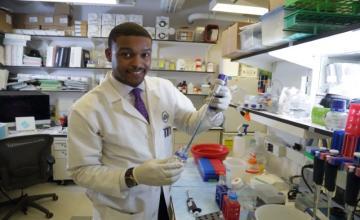 NIDCR is seeking outstanding applicants for the position of director for the Division of Extramural Activities to provide leadership and advice in developing, implementing, and coordinating the institute's extramural programs and policies; application deadline is July 7. NIDCR also has a new opening for a postdoctoral research position in the Craniofacial Anomalies and Regeneration Section. Learn more on NIDCR's job openings page. |
Back to top
 To bolster research to help communities disproportionately affected by COVID-19, NIH is funding $29 million in additional grants for the NIH Community Engagement Alliance Against COVID-19 Disparities. The awards will help strengthen COVID-19 vaccine confidence, access, testing, and treatment in communities of color, as well as extend the reach of COVID-19 community-engaged research and outreach. The NIH-wide effort is led by the National Institute on Minority Health and Health Disparities and the National Heart, Lung, and Blood Institute. |  In April, NIH Director Francis S. Collins, MD, PhD, testified before the House Energy and Commerce Health Subcommittee regarding NIH's plans to study "long COVID"—a constellation of symptoms that persist in patients after initial SARS-CoV-2 infection. Since Congress appropriated $1.15 billion for this work in December 2020, NIH has been working to design a fast, flexible, and comprehensive research initiative. NIH experts also recently published a paper in the Annals of Internal Medicine that outlines what is known about long COVID and the knowledge gaps that need to be addressed in future research. |  Dr. Collins and several NIH leaders appeared before the Senate Appropriation Subcommittee on Labor, HHS, Education, and Related Agencies to discuss the fiscal year 2022 NIH budget request. Dr. Collins stated that the proposed $51 billion budget will continue to fund research addressing the impact of the pandemic and tackle some of our nation's most persistent health challenges, including health disparities, maternal mortality, mental health, and opioid use disorder. In addition, the 2022 budget proposes to establish the Advanced Research Projects Agency for Health (ARPA-H), which is designed to tackle bold challenges through a non-traditional and nimble approach to high risk research. | 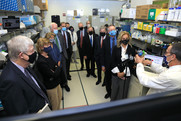 On May 17, NIH welcomed back members of Congress to campus, where a group of US senators toured the Vaccine Research Center, heard about the RADx pipeline of new COVID-19 testing technologies, and learned of emerging research on the effects of the pandemic on mental health. | 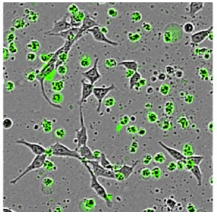 Researchers at the National Center for Advancing Translational Sciences (NCATS) have devised a four-component small-molecule cocktail that can protect stem cells called induced pluripotent stem cells from stress and help them maintain normal structure and function. The researchers showed that the cocktail can improve stem cell survival and quality, enhancing their potential for future use in therapeutic applications and in research, including genome editing. | 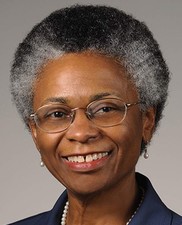 Dr. Collins selected Marie A. Bernard, MD, as NIH's chief officer for scientific workforce diversity (COSWD) after a nationwide search. A geriatrician, Bernard has served as deputy director of the National Institute on Aging since October 2008 and the acting COSWD since October 2020. She has had a leadership role in several NIH initiatives to enhance diversity, including the recently launched UNITE initiative, an effort to end structural racism in biomedical research. | 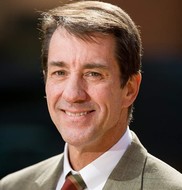 After nearly a decade of leadership as the founding director of NCATS, Christopher P. Austin, MD, departed NIH to join a life sciences platforms company in Cambridge, Massachusetts, as CEO-partner. Austin led NCATS in developing new approaches that speed therapeutic development for all diseases. Following Austin's departure, NCATS deputy director Joni Rutter, PhD, stepped in as acting director while a nationwide search for a new director takes place. |  Eric Lander, PhD, was confirmed as the 11th director of the White House Office of Science and Technology Policy by the US Senate on May 8. Lander will also serve as the President's science advisor. Prior to joining the White House, Lander served as the founding director of the Broad Institute of the Massachusetts Institute of Technology and Harvard University and was one of the principal leaders of the Human Genome Project. He received his bachelor's degree from Princeton University and his PhD from Oxford University, UK. | Back to top 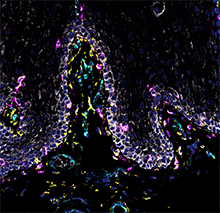 NIDCR scientists catalogued 120,000 oral mucosa cells by type and function, revealing a role for connective tissue cells in orchestrating immune responses linked to gum disease. The cell atlas is designed to serve as a detailed community resource to help researchers answer key questions about oral biology and disease. |  NIDCR Lasker Clinical Research Scholar Jacqueline Mays, DDS, MHSc, PhD, is unravelling why bone marrow or blood stem cell transplant patients' new immune systems sometimes attack the mouth, a condition called chronic oral graft-versus-host disease. Patients with the condition often have oral ulcers, difficulty opening their mouths, and salivary gland damage that makes eating and oral care difficult. Her findings may help scientists find better treatments and diagnostic tools and even offer insights to how the body responds to coronavirus infection. | 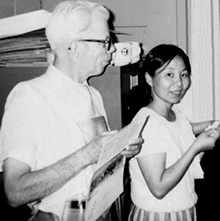 Biochemist Myung Hee Park, PhD, reflects on her 42-year career at NIDCR, where she pioneered research on a new molecular pathway vital for nearly all life. Her work opened a new field of research that could shed light on new approaches to treat certain cancers and neurodevelopmental disorders. Park retired on June 30 and will continue to serve as a special volunteer at the NIH, providing her expertise to collaborators. | 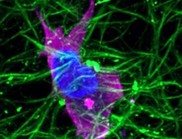 NIDCR scientists captured video of a human fibroblast cell creeping and crawling through a web of proteins, demonstrating a "front wheel drive" mechanism to migrate through the body—a method distinct from cancer cells. The findings, published in Developmental Cell, could shed light on ways to thwart the invasion and spread of cancers, including those of the head and neck. | 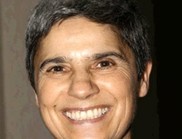 NIDCR researcher Eva Mezey, MD, PhD, Dsc, and colleagues demonstrated the presence of lymphatic vessel cells and immune cells throughout the brains of humans, suggesting our immune systems may be policing our brains. Their findings point to the existence of a lymphatic network that acts as a waste drainage system for the brain and may serve as a bidirectional conduit between the brain and immune system. |  Early-stage researchers shared their experiences in an NIDCR-supported program led by the American Association for Dental Research to provide one-on-one mentoring and career-related training to individuals from diverse backgrounds. Called Mentoring an Inclusive Network of a Diverse Workforce of the Future (MIND the Future), the year-long program is designed to support scientists in the transition to research independence and enhance the diversity of the dental, oral, and craniofacial research workforce. |  NIDCR Lasker Clinical Research Scholar Alison Boyce, MD, is searching for treatments for fibrous dysplasia/McCune-Albright syndrome (FD/MAS), a rare disease of the bones, endocrine system, and skin, which can impair quality of life. She leads the FD/MAS natural history study at NIH, characterizing patients' signs and symptoms to understand disease progression. In an ongoing clinical trial, her team is investigating the safety and effectiveness of potential therapeutics in adults with bone manifestations of FD/MAS. |
Back to top
Sanford Burnham Prebys - June 7, 2021 University of Michigan - May 26, 2021 University at Buffalo - May 25, 2021 University of Pennsylvania - May 18, 2021 Pennsylvania State University - April 26, 2021 University of Colorado - April 19, 2021 KU Leuven - April 5, 2021 Back to top Back to top Visit the NIDCR website to sign up for NIDCR News. Back to top |

No comments:
Post a Comment